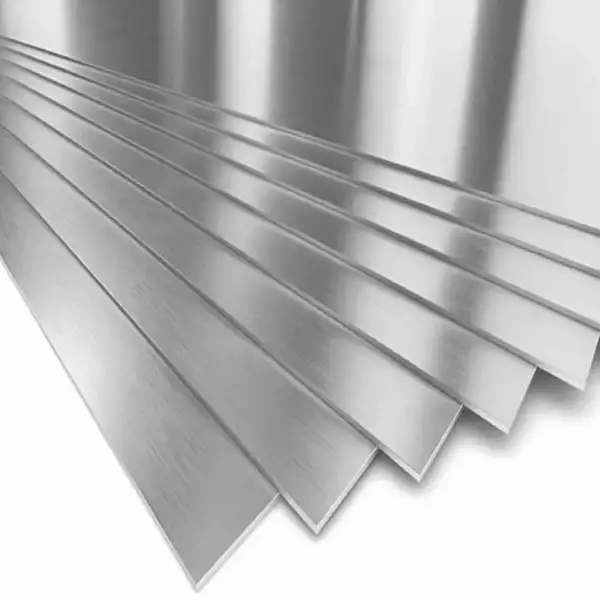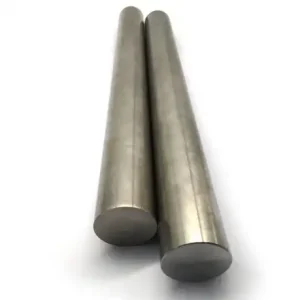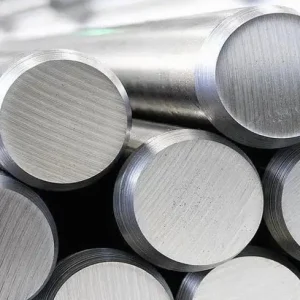If you need a sheet material that combines excellent resistance to galling and metal-to-metal wear with superior cavitation and seawater performance — while retaining the ease of fabrication of an austenitic stainless — Nitronic 60 sheet (UNS S21800) is a top candidate. It typically offers roughly double the yield strength of common 300-series grades, markedly better self-mated galling resistance, and improved chloride/pitting resistance versus Type 316 in many service conditions, making it particularly well suited for valve trim, pump wear rings, fasteners and marine components.
What is Nitronic 60?
Nitronic is a trade name for a family of nitrogen-strengthened austenitic stainless steels originally developed by Armco and now associated with the Nitronic trademark. Nitronic 60 (often listed as Alloy 218 or UNS S21800) is the grade engineered specifically for resistance to galling, adhesive wear and cavitation erosion while retaining good corrosion resistance and toughness across a wide temperature range. The nitrogen addition raises yield strength without relying on age-hardening and helps the alloy remain fully austenitic after cold work.
Chemical composition
Below is a concise composition table for Nitronic 60 as reported in common product data sheets and manufacturer literature. Minor variations exist between suppliers and “high strength” processed variants; always confirm the certificate of analysis for supplied material.
| Element | Typical content (wt.%) – Nitronic 60 (UNS S21800) |
|---|---|
| Chromium (Cr) | ~16–18 wt% |
| Nickel (Ni) | ~7–9 wt% |
| Manganese (Mn) | ~7–9 wt% |
| Silicon (Si) | ~3.5–4.2 wt% |
| Nitrogen (N) | ~0.10–0.18 wt% |
| Carbon (C) | ≤ ~0.08–0.10 wt% |
| Molybdenum (Mo) | trace / small (varies by subgrade) |
| Iron (Fe) | Balance |
(These typical values are summarized from supplier data and product bulletins.)
Note on “High Strength” Nitronic 60: some producers offer a cold-worked “HS” version obtained by special mill processing; composition is similar but strength is increased by plastic deformation rather than by heat treatment.
Mechanical properties
Mechanical properties vary with form and processing. The table below provides representative room-temperature numbers used by designers; check mill certificates for the sheet you buy.
| Property | Annealed typical (sheet) | Cold-worked / HS typical |
|---|---|---|
| 0.2% Proof (Yield) | ~40–70 ksi (≈275–485 MPa) typical range depends on thickness | Up to >100 ksi (≈690 MPa) in HS bar/wire forms |
| Tensile strength (UTS) | ~85–140 ksi (≈585–965 MPa) | Up to ~190–276 ksi reported for highly cold-worked wire/bars (not typical of sheet). |
| Elongation in 2 in | ~20–40% (annealed) | Reduced with cold work |
| Hardness (HRC or HRB) | Moderate (annealed) | Higher with cold work |
| Operating temperature | −200 °C up to ~900 °C for oxidation resistance; retains strength up to ~1800 °F in some uses | Depends on processing |
Manufacturers commonly state that Nitronic 60 offers roughly twice the yield strength of Type 304/316 in the annealed condition, a statement grounded in comparative test data and product bulletins.
Why Nitronic 60 resists galling, wear and cavitation
Three alloying features give Nitronic 60 its special wear behaviour:
-
High silicon and manganese create a matrix that reduces adhesive interaction at sliding contacts and inhibits the formation of transfer films that trigger galling.
-
Nitrogen increases austenite stability and solution-strengthens the matrix, raising yield and shear strength — critical to prevent local cold-welding under compressive contact.
-
Uniform austenitic microstructure (retained after cold work) plus stable passive film formation help resist micro-fatigue pitting that can initiate cavitation erosion.
The combined effect is an alloy that performs similar to some cobalt-base alloys for cavitation resistance and greatly outperforms standard 300-series stainless in self-mated wear tests, while remaining much less expensive and easier to machine than cobalt alloys. This is why Nitronic 60 is widely recommended for pump wear rings, valve seats and fasteners where galling or cavitation is a risk.
Corrosion behaviour
General corrosion resistance of Nitronic 60 typically lies between Type 304 and Type 316 for many aqueous media. However, pitting, crevice and chloride stress-corrosion performance is often superior to 316 because silicon and nitrogen help stabilize the passive film and raise local resistance to pit initiation. Controlled seawater exposures reported in product literature show Nitronic 60 exhibiting equal or slightly better crevice resistance than 316 in calm seawater tests lasting months. Designers must still evaluate real service conditions (flowing seawater, biofouling, oxygenation, temperature and contaminants).
Key checklist for corrosion use:
-
For heavily chlorinated, stagnant, or high-temperature chloride environments, verify pitting resistance (PREN) against service conditions; Nitronic 60 is not a direct substitute for super-austenitics or duplex in highly aggressive chloride service.
-
In mixed wear + corrosive service (e.g., pump impellers handling seawater), the superior wear/galling resistance often delays failure modes that normally accelerate corrosion—making Nitronic 60 the practical choice.
Fabrication: cutting, forming, welding and surface finish notes
Cutting & machining: Nitronic 60 in sheet form machines like other austenitic stainless steels, but its higher strength can accelerate tool wear. Use appropriate carbide tooling, moderate feeds and rigid fixturing. Lubrication and chip control are important.
Forming: Annealed sheet forms readily. The alloy work-hardens—so form in multiple small bends rather than single severe bends when possible; for complex stamping, consider annealing cycles between operations.
Welding: Nitronic 60 welds with conventional processes (GTAW/TIG, GMAW/MIG). Autogenous GTA welds are sound and welding consumables classified for Nitronic 60 or austenitic stainless filler (e.g., ER218 or AWS ER218) are used for best wear properties of weld metal. Post-weld heat treatment is generally not required except where corrosion resistance dictates (heavy section stress relief). Weld metal wear tends to be slightly lower than base metal, so critical wear surfaces may require deposition welding with matched filler or post-weld overlays.
Surface finish: For wear parts, final surface finish and mating surface metallurgy matter a lot. Polished or ground finishes lower friction and reduce initiation sites for galling. When two Nitronic 60 surfaces are mated, performance is excellent even in relatively rough finishes, but the best service life often comes from careful surface planning and lubricant considerations.
Standard specifications and material equivalents
Common references tied to Nitronic 60:
-
UNS designation: S21800 (commonly used in material certificates).
-
AMS/Manufacturer bulletins: AMS 5848 and product data sheets exist for Nitronic 60 variants used in aerospace or high-integrity components.
-
Trade name owner / data: ARMCO / AK Steel / Cleveland-Cliffs maintain technical bulletins on Nitronic family alloys.
Equivalents: There is no perfect one-for-one standard alloy named identically across all spec lists — Nitronic 60 is proprietary/registered as a family trade name. Some manufacturers use the descriptor “Alloy 218” or list UNS S21800. If a strict standard is required in a procurement document, list UNS S21800 and the producing mill or licensed manufacturer to avoid ambiguity.
Typical sheet applications and industry examples
Nitronic 60 sheet is chosen where sliding contacts, fretting, cavitation or adhesive wear combine with corrosive exposure or where failure by galling is unacceptable. Representative uses:
-
Valve trim (stems, seats, guides) — galling resistance preserves tolerances and reduces seizure risk.
-
Pump components (wear rings, impellers, shafts) — cavitation and erosive wear resistance extends service life in hydropower and petrochemical pumps.
-
Fasteners and nuts in brackish/seawater environments where galling is a known failure mode.
-
Hydropower and marine hardware — bridge pins, bearings, and bushings where mixed wear/corrosion is present.
-
Mating shafts and sliding guides in food, pharmaceutical and chemical plant where galling would cause catastrophic stoppages.
Short case note: manufacturers of hydroelectric turbines and pump OEMs commonly specify Nitronic 60 for wear rings and valve components because real field tests combine mechanical wear and seawater exposure where Nitronic 60 outperforms common stainless steels.
Design and engineering considerations
A few pragmatic rules for designers using Nitronic 60 sheet:
-
Mating materials: While Nitronic 60 performs very well even when self-mated, in highly loaded sliding pairs consider a dissimilar pairing (e.g., Nitronic 60 against a harder carbide or coated surface) to reduce adhesive transfer. Avoid pairing with softer 300-series stainless parts that may gall or wear prematurely.
-
Lubrication: Where feasible, provide boundary lubrication or appropriate film lubricants. Nitronic 60 makes lubrication more forgiving but does not eliminate the benefits of proper lubrication.
-
Thickness & stiffness: Nitronic 60 sheet has higher yield, so thinner sections may achieve the same stiffness as thicker 316 sheet — but check fatigue and buckling behavior, especially in cyclic load cases.
-
Fastener selection: For bolts and nuts, specify Nitronic 60 fasteners where repeated assembly/disassembly occurs in corrosive service; the alloy’s galling resistance reduces thread seizure risk.
-
Surface hardening: Carbide overlays or weld overlays can be used if extreme abrasive wear is expected; however, this raises cost and complicates fabrication.
Procurement, tolerances, thicknesses & cost drivers
Available forms: sheet, plate, strip, coils, bars and fasteners. Sheet thickness availability depends on the mill — common sheet/plate ranges are similar to other stainless grades but check producers for thin stock (<1 mm) or heavy plate (>25 mm).
Tolerances: Use supplier mill tolerances for thickness, flatness and surface finish in purchase orders. For critical wear parts, ask for test certificates showing chemistry, tensile, hardness and any cold-work percentage.
Cost drivers: Nitronic 60 is typically more expensive than standard 304/316 because of alloying additions (Si, Mn, N) and smaller market volumes, but is far less costly and easier to machine than cobalt-based wear alloys. The total installed cost frequently favors Nitronic 60 where downtime, replacements or specialty coatings would otherwise be required. Rolled Alloys
Environmental, inspection and failure modes
Common failure modes to watch:
-
If galling occurs, it typically precedes measurable abrasive wear and then accelerates corrosion. Design to prevent initiation (surface finish, mating material, lubrication).
-
In highly aggressive chloride environments at elevated temperatures, heavy pitting and crevice corrosion may occur; test coupons for severe services.
-
Cold work increases strength but may reduce corrosion resistance; if HS (cold-worked) material is specified, validate corrosion performance for the service.
Inspection: For critical wear parts, use periodic dimensional checks, surface finish monitoring and non-destructive evaluation where appropriate (ultrasonic thickness for wall components, visual and magnetic particle for welds if ferromagnetic inclusions exist).
Practical recommendations and summary
-
Use Nitronic 60 sheet when galling, adhesive wear or cavitation erosion are the primary risks and where 316/304 would fail early due to seizure or rapid wear.
-
Confirm supplier data: demand mill test certificates and, when using HS (cold-worked) variants, confirm the mechanical and corrosion properties for the exact product form.
-
Welding & joining: standard austenitic practices apply; for best wear life, evaluate weld metal and consider overlay if the weld zone will see high metal-to-metal wear.
Nitronic 60 sheet is a specialist austenitic stainless that gives engineers a cost-effective bridge between standard stainless and expensive cobalt/nickel wear alloys, especially in marine, pump and valve applications.
Composition & properties quick reference
Composition (typical)
| Element | Typical wt.% |
|---|---|
| Cr | 16–18 |
| Ni | 7–9 |
| Mn | 7–9 |
| Si | 3.5–4.2 |
| N | 0.10–0.18 |
| C | ≤0.10 |
| Fe | Balance |
Source: manufacturer product bulletins and technical data sheets.
Representative mechanical properties (annealed sheet)
| Property | Typical value |
|---|---|
| 0.2% proof (yield) | ~40–70 ksi (275–485 MPa) |
| Tensile strength | ~85–140 ksi (585–965 MPa) |
| Elongation | ~20–40% (depends on thickness) |
| Hardness | Moderate (increases with cold work) |
FAQs
-
What is Nitronic 60 sheet used for?
Primarily for wear-prone components — valve trim, pump wear rings, fasteners and sliding parts in marine and hydraulic systems where galling and cavitation are concerns. -
Is Nitronic 60 magnetic?
Nitronic 60 is essentially non-magnetic in the annealed austenitic condition; cold work can induce slight magnetic response but it remains very low. -
Can Nitronic 60 be welded?
Yes. It welds with conventional austenitic stainless procedures. Autogenous GTAW welds and matching filler metals produce sound welds; wear in weld metal is slightly lower than base metal. -
How does Nitronic 60 compare to 316 stainless?
Nitronic 60 typically has higher yield strength (roughly double), superior galling and cavitation resistance and equal or better crevice/pitting resistance in many seawater tests; however, 316 may still be preferred in highly aggressive chloride corrosion when other factors dominate. -
Is Nitronic 60 the same as Nitronic 50?
No. They are different alloys in the Nitronic family — Nitronic 50 emphasizes marine strength and corrosion resistance, whereas Nitronic 60 is developed specifically for galling and wear resistance. -
What are common sheet thicknesses available?
Availability varies by mill. Nitronic 60 is produced in sheet and plate ranges similar to other stainless grades; confirm with suppliers for thin gauge (<1 mm) or heavy plate sizes. -
Does Nitronic 60 require special heat treatment?
No tempering or age hardening is required for the standard grade. “High strength” conditions are achieved by cold work; annealing restores ductility if needed. -
Can Nitronic 60 be used in seawater?
Yes — product tests show good crevice/pitting resistance in quiet seawater, often outperforming 316 in similar tests — but evaluate the full service environment (velocity, fouling, temperature) before final selection. -
What is the UNS number for Nitronic 60?
UNS S21800 (often also referenced as Alloy 218 in older literature). -
Is Nitronic 60 worth the extra cost?
When galling, seizure or cavitation reduce mean time between repairs, Nitronic 60 frequently lowers life-cycle cost by extending service intervals and avoiding unplanned downtime — thus it often pays back the premium. Consider a simple LCC (life-cycle cost) calculation for critical parts.
Authoritative references
- Nitronic (Wikipedia) — overview of the Nitronic family and UNS designations
- ARMCO / AK Steel — Nitronic® 60 Product Data Bulletin (technical performance & seawater test summaries)
- High Performance Alloys — Nitronic 60 brochure and test datasheets (galling & cavitation data)
- Electralloy / Specialty Steel Supply — Nitronic 60 technical bulletin (welding, application guidance)
Final practical checklist
-
Specify UNS S21800 and the producing mill or licensed manufacturer to avoid substitution ambiguity.
-
Request mill test reports (chemistry, tensile, hardness) and relevant processing history (annealed or cold-worked HS).
-
For wear-critical welds, ask for weld procedure qualifications and sample overlay tests, and consider specifying post-fabrication machining and finish tolerances.
-
Where seawater or cavitating flow is present, demand coupon tests or reference to the manufacturer’s cavitation/crevice data.





